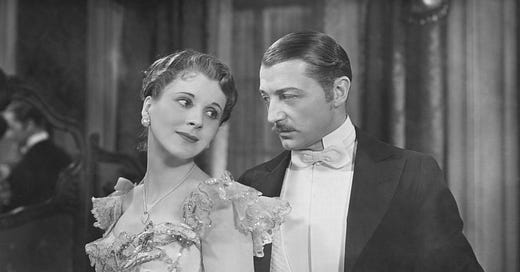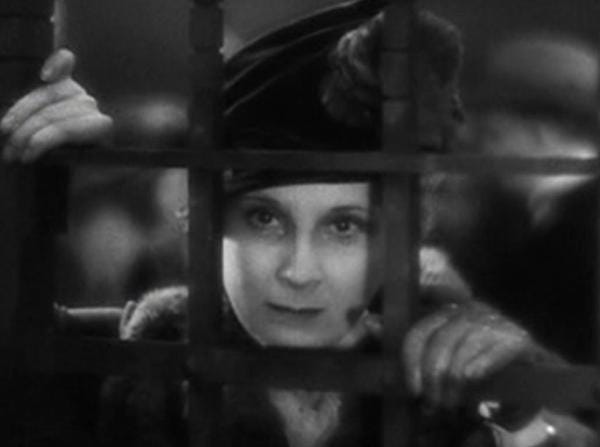Reeling Backward: Cavalcade (1933)
One of the earliest Best Picture Oscar winners has all the hallmark limitations of its time, but is still a moving and effective look at one British family through years of war, strife and joy.
When I was a child, I did not very much care for old movies. I found them stiff, theatrical and dull. For a kid raised on “Jaws,” “Smokey and the Bandit” and “Star Wars,” movies from the 1920s through 1950s just didn’t hold much appeal for me. I thought of them as “old people” films.
In fact, “Cavalcade,” the winner of the Academy Award for the Best Picture of 1933, pretty much typifies exactly the sort of old-fashioned moviemaking I eschewed as a youngster.
Now that I am, as Evelyn Couch put it in “Fried Green Tomatoes,” “too young to be old and too old to be young,” I am pleased to have much more affinity for classic films, including “Cavalcade.” While it has the hallmark limitations of its time, it’s still a moving and effective look at one British family through years of war, strife and joy.
Translated from the Noël Coward play, it’s the story of the Marryot clan, a well-to-do family living in London on New Year’s Eve 1899. The story encompasses that time until 1933, with a particular focus on the Second Boer War and World War I, skipping over the whole of the 1920s with a harrowing montage showing wild dancing and drinking, jazz crooners and even homosexual couples(!) as examples of the moral rot taking over English society.
This overwrought bit of moralizing aside, it’s a largely sentimental piece focusing on family triumphs and tragedies — you might even call it melodramatic.
Diana Wynyard and Clive Brook play the parents, Jane and Robert, though it would be fair to say that she stands more or less at the center of the story while her husband is the doughty, reliable supporting figure. The opening title cards refer to the love of a mother holding everyone together, and there are even several instances where Jane turns to the camera and speaks to the audience sotto voce — a conceit carried over from the stage version.
The first section deals with Robert and the family Butler, Alfred Bridges (Herbert Mundin), volunteering to go off and fight in the Boer War. Alfred’s wife, Ellen (Una O'Connor), a pinch-faced woman with a screechy voice often employed for comic relief, also works for the Marryots as a maid. She and Jane bond over their shared worry for their husbands, resulting in a relationship that’s more familiar than the typical master/domestic one.
The Marryots have two sons, older Edward (Dick Henderson, Jr.), the steadfast one, and scampy Joey (Douglas Scott), always getting into scrapes. Jane’s best friend, Margaret (Irene Browne), has a daughter, Edith, about the same age, and the children play together while the fathers are away at war.
Both men return home safe, but things don’t turn out well for Alfred. He buys a beer house but takes to the drink himself, becoming abusive and soon dying in a tragic accident. This leaves Ellen to fend for herself with a young daughter, Fanny (Bonita Granville), who’s become talented dancer.
Flash forward to 1912, and Edward and Edith, now played by John Warburton and Margaret Lindsay, have fallen in love and gotten married, delighting their mothers. As it happens, though, their honeymoon trip is aboard the R.M.S. Titanic.
(Sorry, no spoiler warnings after 90 years.)
When the world war breaks out, both Robert and son Joe (Frank Lawton) sign up to serve. Unlike the Boer war that lasted barely a year, this one drags on year after year through trench warfare. Robert is too old for the front lines, working instead as a railroad station commander.
While home on leave, Joe encounters Fanny Bridges (Ursula Jeans), who has become a song-and-dance sensation, at one of her shows. They fall for each other and mean to get married, which causes tension between Jane and Ellen. They have a spat where Mrs. Bridges scolds her former mistress for resisting the changing society that’s becoming less feudal and (a bit) more egalitarian.
That leads to this from Mrs. Marryot, less of a retort than a pronouncement of regret: “Something seems to have gone out of all of us, and I'm not sure I like what is left.”
Their dilemma is solved when Joe is killed in the hours before the armistice is declared.
Reginald Berkeley handled the screenplay adaptation of Coward’s play, and Frank Lloyd directed. He had previously won the best director Oscar for 1931’s “The Divine Lady,” and would capture the prize again for “Cavalcade.” The excellent art direction by William S. Darling also won, and Wynyard was nominated for best actress in a leading role.
The time lapses between sections are marked by a cavalcade as knights on horses pass in the background — a literal march of time.
Lloyd also employs several cacophonous montages that mix different footage and pieces of music or sound, overlapping and bumping up against each other. One of the most effective shows the passage of the war years, as young men’s bodies sag or stagger as they are shot, their faces falling into the mud like rag dolls.
I was also captivated by a shot of Jane, her face pressed against the bars of a gate as she watches her son go off to war, director Lloyd pulling the camera back so we can feel her mounting sorrow. Cinematography by Ernest Palmer.
Losing both their sons would the sort of thing to send most couples into a delorious stupor, and I suppose this explains why the years from 1918 to 1933 are largely passed over in another montage, with Fanny showing up to sing a sad, bluesy tune.
The last sequence shows Jane and Robert, now aged in very convincing makeup, still together and very much in love. Their last speech, again delivered straight to the camera, essentially marries their plight to the whole of England, recognizing all the tremendous losses and tragedy they’ve incurred, but resolving to carry on with dignity and thankfulness.
I admit I’m surprised I enjoyed “Cavalcade” as much as I did. While it certainly doesn’t rise to even the top half of all Best Picture winners in my opinion, it’s a technically impressive and emotionally resonant piece of filmmaking.






